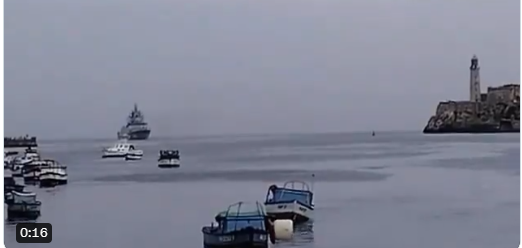It was all a show of force. But Russia’s diminished power in comparison to the old Soviet Union, had many in the U.S. Navy and military forces of the U.S. looking at the Russian vessels as target practice if any hostilities were to break out. Putin knows full well that he is no match for NATO, and has said as much a number of times.
Amid ongoing tensions and strategic posturing, Russian President Vladimir Putin, a figure reminiscent of Cold War dynamics, remains particularly focused on regions like Cuba and Florida. In a dramatic gesture in 2018, Putin released a video depicting a simulated Russian nuclear strike on Miami. This act seems to reflect Putin’s broader strategy of showcasing military might in response to NATO’s significant ramping up of allied exercises, which are the largest since the 1980s. In a direct counter, Putin has initiated naval drills off the coast of Florida.
How does it feel to have Russian submarines and war ships 90 miles off the coast of Florida? In Cuba!
The Biden administration has been funding the war between Russia and Ukraine and it seems to me that Putin has had enough.
Putin is making his move to show the US that this war… pic.twitter.com/KEU3Gxg5UU
— 𝑮𝑰𝑳𝑩𝑬𝑹𝑻 𝑲𝑰𝑩𝑰𝑾𝑶𝑻 🇰🇪 (@gilbertkibiwot4) June 16, 2024
In a strategic pivot away from the increasingly vulnerable Black Sea, Russia has deployed two of its premier warships to Cuba, both equipped with state-of-the-art hypersonic missiles. The arrival of these vessels on a recent Tuesday underscores a significant escalation in military capabilities and a shift in geographical focus.
Supporting these advanced warships are an oiler for refueling and a salvage tug, highlighting the logistical challenges and the necessity for self-sufficiency in extended naval operations. These ships include the frigate Admiral Gorshkov, a stark example of modern naval design in stealth technology, and the guided-missile submarine Kazan, both notable for their advanced technological arsenals and quieter, more effective operational capabilities.
🚨Update: Two U.S. Navy destroyers are monitoring a fleet of Russian ships that are within 66 miles of Florida, now in Cuba for wargames with the Cuban Navy!
Analysts say Russia is sending a strategic warning to the United States after NATO authorized Ukraine to carry out… pic.twitter.com/Qnd6Q48WdT
— US Civil Defense News (@CaptCoronado) June 11, 2024
The Admiral Gorshkov and Kazan are equipped with Zircon hypersonic missiles, capable of reaching speeds of Mach 9. These missiles pose a formidable threat due to their speed, maneuverability, and potential nuclear capability, although they face limitations in target acquisition at lower speeds. Putin has expressed particular admiration for the Zircon, calling it a “unique weapon” unparalleled worldwide, and has used the Admiral Gorshkov as a primary testing platform for these missiles.
As Russia continues with its naval exercises, the U.S. is not merely a passive observer. The Pentagon, under the watchful eyes of analysts and military strategists, monitors these maneuvers closely. U.S. naval and air forces, enhanced by cooperation with Canada, are actively tracking Russian activities. This includes advanced radar systems aboard the U.S. Navy’s P-8 Poseidon aircraft, which allow detailed surveillance capabilities.
🚨 GERALD CELENTE – Possibility of a False Flag attack before Democratic National Convention to get American People onboard with WW3.#WW3 #Russia #Florida #Truth #RussianSubmarines #Cuba #Havana pic.twitter.com/f02ZgRHcI7
— T R U T H P O L E (@Truthpolex) June 13, 2024
The U.S. Coast Guard is also involved, with the National Security Cutter Stone playing a significant role. This cutter, among the largest and most technologically advanced in the Coast Guard’s fleet, along with the Navy’s Arleigh Burke-class Aegis destroyers, stands ready to counter any threats. These units, equipped with comprehensive missile defense systems, are prepared to engage if necessary.
The implications of these naval drills extend beyond immediate tactical concerns. They provide the U.S. with valuable intelligence on Russian naval capabilities and operational tactics, while also serving as a real-time training scenario to refine U.S. responses to potential threats.
Major Points
- Russian President Vladimir Putin, influenced by Cold War dynamics, focuses on strategic interests in Cuba and Florida, showcasing Russian military capabilities through naval exercises near Florida.
- In response to heightened NATO activities, Russia relocates two advanced warships from the vulnerable Black Sea to Cuba, equipped with state-of-the-art hypersonic missiles.
- The Russian naval deployment includes logistical support vessels—an oiler and a salvage tug—to ensure sustained operations and preparedness for emergencies.
- The U.S. monitors these maneuvers closely, employing advanced radar systems and coordinating with Canadian forces, enhancing surveillance and defensive readiness.
- This strategic posturing by Russia not only tests U.S. and NATO responses but also provides the U.S. military with valuable insights into Russian naval operations and electronic tactics.
Lap Fu Ip – Reprinted with permission of Whatfinger News



